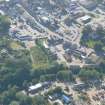Dingwall Churchyard
Pictish Symbol Stone (Pictish)
Site Name Dingwall Churchyard
Classification Pictish Symbol Stone (Pictish)
Canmore ID 12820
Site Number NH55NW 7
NGR NH 54943 58947
Datum OSGB36 - NGR
Permalink http://canmore.org.uk/site/12820
- Council Highland
- Parish Dingwall
- Former Region Highland
- Former District Ross And Cromarty
- Former County Ross And Cromarty
Dingwall, Ross and Cromarty, Pictish symbol stone
Measurements: H 1.30m above ground level, W 0.51m, D 0.20m
Stone type: mica schist
Place of discovery: NH 5493 5893
Present location: in the churchyard at Dingwall.
Evidence for discovery: identified by W C Joass in 1880, when it was in re-use as a lintel over a doorway in the 1803 church. It was removed and set in a stone base in the churchyard near the entrance.
Present condition: very weathered on both carved faces, broken at the top (base hidden).
Description
This was originally a prehistoric cup-marked stone bearing a number of cupmarks on both broad faces, which was later re-used as a symbol stone. It is incised on one broad face with three open circles above a crescent and V-rod and on the other broad face with a double disc and Z-rod above two crescents and V-rods arranged one above the other.
Date: seventh century.
References: ECMS pt 3, 56-7; Fraser 2008, no 120.
Compiled by A Ritchie 2017
NH55NW 7 5493 5893.
A cup marked, Class I symbol stone, which had been used as a lintel over a doorway of the church built in 1801, was identified in 1880 and is now erected on a base in the churchyard opposite the entrance gateway. It is a rectangular slab of mica schist, 4'3" high by 1'8" wide by 8" thick, bearing on the front the double disc and Z-rod, and two crescent and V-rods; and on the back three circles and the crecent and V-rod as well as six cup marks.
J R Allen 1903.
As described above, this stone was located at NH 5493 5893 in Dingwall churchyard.
Visited by OS (W D J) 17 April 1963
No change.
Visited by RCAHMS (JRS) March 1989.
Class I symbol stone bearing, on the west face,a double-disc and Z-rod with crescents and V-rods at both the centre and the foot of the stone.
A Mack 1997
Field Visit (September 1978)
Dingwall, Symbol Stone NH 549 589 NH55NW 7
A Class I 'Pictish' symbol stone, which stands in front of Dingwall Parish Church, bears double disc, crescent, circle, Z- and V-rod decoration, and six cup-marks.
RCAHMS 1979, September 1978
(Allen and Anderson, 1 903, iii, 56-7)






















































